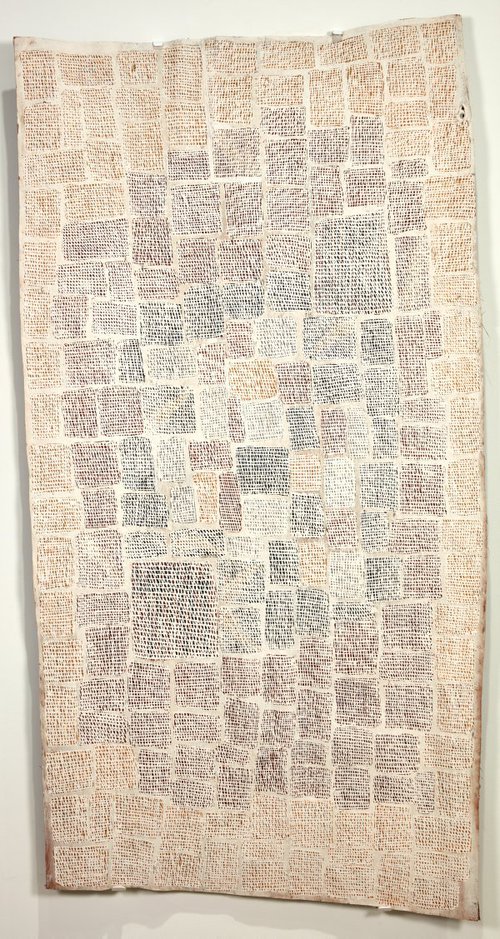Title
Rapiny Gapu
2015
Artist
-
Details
- Place where the work was made
-
Yirrkala
→
North-east Arnhem Land
→
Northern Territory
→
Australia
- Cultural origin
- Djapu/Arnhem region
- Date
- 2015
- Media category
- Materials used
- etching on paper
- Edition
- 21/30
- Dimensions
- 40.0 x 40.0 cm
- Signature & date
Signed l.r corner, pencil 'Marrnyula Mununggur'
- Credit
- Purchased with funds provided by the Aboriginal Art Collection Benefactors 2015
- Location
- Not on display
- Accession number
- 255.2015
- Copyright
- © Marrnyula Mununggurr. Buku-Larrnggay Mulka Centre, Yirrkala
- Artist information
-
Marrnyula Munuŋgurr
Works in the collection
- Share
-
-
About
Marrnyula Munuŋgurr is among the generation of exceptional female artists working at Yirrkala who have been taught to paint by their fathers and grandfathers and are now painting many of the sites and designs that would once have been the sole domain of men. Munuŋgurr was instructed in painting by her father, Djutjadjutja Munuŋgurr and now works closely with her mother, Noŋgirrŋa Marawili, also an artist. Munuŋgurr began her career as a printmaker and was for many years the senior printmaker at Yirrkala Printspace. Her attention to detail, consistency in application and clarity of design are informed by this experience.
The strong grid pattern dominating 'Rapiny Gapu' 2015 refers to the Djapu clan site of Wandawuy. This outstation is surrounded by permanent freshwater and is associated with both Mäna, the ancestral shark, and Bol'ŋu, the thunderman. Rains inspired by the actions of Bol'ŋu feed the rivers and fill the billabongs, resulting in a rich sea life that is a home for mäna. The grid refers to the landscape of the site, a network of billabongs surrounded by ridges and high banks and also relates to the grid of a woven fish trap set here by ancestral hunters.
Art centre documentation states:
The cross hatching grid pattern is the sacred design for the freshwaters of the Djapu clan at their homeland Wandawuy now an outstation about 150 kilometres south of Yirrkala and inland from Blue Mud Bay.This Djapu clan outstation (and spiritual residence for Ancestral Beings Måna the Shark and Bol’ŋu the Thunderman) is surrounded by permanent freshwater. Rains inspired by the actions of Bol’ŋu feed the rivers and fill the billabongs. Catfish and mussels, freshwater crayfish and others feed the Yolŋu and wildlife. The waters are home for the shark Måna. The grid refers to the landscape of Wandawuy- a network of billabongs surrounded by ridges and high banks. Its structure also having reference at one level to woven fish traps.
Ancestral Hunters set a trap here to snare the Shark but to no avail. These Yolŋu people are called Bårngbarng and Monua who came to cut the trees named Gugnuwu, Gathurrmakarr, Nyenyi, Rulwirrika and Gananyarra – all Dhuwa trees.
Måna the Ancestral Shark in its epic travels comes through this way. These ancestors try to trap Måna in the freshwater by means of these traps in the waterways. They fail. The powers and physical strength of the Shark overcome the efforts of mere mortals. Måna’s ire and thrashing tail smash the trap and muddy the water.
They witness however the strength of Måna and sing his actions, the thrashing of his tail for one, the muddying or contamination of the water. The lines having reference to the trap, the verticals referring to differing states of the freshwater – the source of Djapu soul.
Recent surveys by Anglo scientists in Top End rivers in Kakadu have revealed the existence of a species of shark whose life cycle takes place entirely in the freshwater. A genus otherwise unknown to Western thought in Australia but present in PNG now known in English as Speartooth.
Wandawuy literally means place of the Sharks head where in the larger context of the song cycles of Mana’s journey his head came to rest after being butchered and distributed through the land.
© Buku Larrŋgay Mulka Art Centre
-
Places
Where the work was made
Yirrkala



